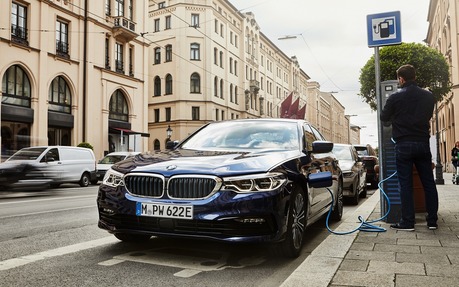BMW 530e Gets a New Battery for a Bit More EV Range
Announced in March at the Geneva Motor Show, the new 2020 BMW 530e xDrive plug-in hybrid sedan is coming soon to Canada with standard all-wheel drive and the latest version of the German automaker’s battery cell technology.
Battery capacity has increased from 9.2 kWh to 12 kWh even though the pack is the exact same size as before, allowing an electric range of up to 58 km based on the WLTP cycle versus 50 km with the previous model. Ratings for North America have yet to be disclosed, but there should be an improvement in EV range from 24 km to about 30 km.
- Also: The Car Guide’s 2019 Best Buys: BMW 5 Series
- Also: 2021 BMW 330e: Plug-in Hybrid with AWD, How Nice!
That’s not exactly a huge gain, although BMW is also claiming a reduction in combined fuel consumption by more than 20 percent (the current 530e xDrive is rated at 3.5 Le/100 km, or 8.3 L/100 km in hybrid operation according to Natural Resources Canada). In order to further improve efficiency, navigation data are used to pro-actively determine the ideal drive mode.

Charging takes less than six hours using a standard power source or 3.5 hours via a level-2 charging station. And once again, the battery is housed under the rear seat to save some room in the trunk (410 litres), but the difference with the conventionally powered versions of the BMW 5 Series (530 litres) is considerable.
There are no changes to the turbocharged 2.0-litre four-cylinder engine and electric motor, so total system output remains at 248 horsepower and 310 pound-feet of torque. This is still controlled by an eight-speed Steptronic transmission. The car accelerates from 0-100 km/h in just over six seconds.
Almost the entire range of 5 Series optional equipment is available for the plug-in hybrid model. This includes the BMW Live Cockpit with its fully digital display design: a high-resolution 12.3-inch instrument cluster behind the steering wheel flanked by a 10.25-inch control display on the centre stack. In the 530e xDrive, drivers can use it to monitor electric range, charging status, the location of public charging stations as well as other information.
BMW’s domestic rivals have yet to come to market with their own plug-in hybrid midsize sedan. The only direct competitor is the Volvo S90 T8.
